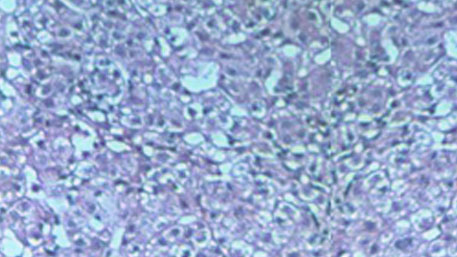 Spotlight
Spotlight
Bird flu virus has been spreading in US cows for months, RNA reveals Genomic analysis suggests that the outbreak probably began in December or January, but a shortage of data is hampering efforts to pin down the source.
(Posted Apr 29, 2024 11AM)
Microbiome-based therapeutics
(Posted Apr 21, 2024 8AM)
Adherence to the Mediterranean diet can beneficially affect the gut microbiota composition: a systematic review
(Posted Apr 19, 2024 10AM)
Dynamic SARS-CoV-2 surveillance model combining seroprevalence and wastewater concentrations for post-vaccine disease burden estimates
RH Holm et al, Comm Med, April 9, 2024 (Posted Apr 10, 2024 8AM)
 Latest News and Publications
Latest News and Publications
Edie Bowen et al. J Genet Couns 2024
A chimeric adenovirus-vectored vaccine based on Beta spike and Delta RBD confers a broad-spectrum neutralization against Omicron-included SARS-CoV-2 variants.
Hong Weiqi, et al. MedComm 2024 0 0. (5) e539
A pioneering EMR-embedded digital health literacy tool reveals healthcare disparities for diverse older adults.
Rousseau Julie, et al. Journal of the American Geriatrics Society 2024 0 0.
Advanced forecasting of COVID-19 epidemic: Leveraging ensemble models, advanced optimization, and decomposition techniques.
Yin Yingyu, et al. Computers in biology and medicine 2024 0 0. 108442
An mRNA technology transfer programme and economic sustainability in health care.
Dutt Devika, et al. Bulletin of the World Health Organization 2024 0 0. (5) 344-351
Analysis of Critical Incident Reports Using Natural Language Processing.
Denecke Kerstin, et al. Studies in health technology and informatics 2024 0 0. 1-6
Association of polymorphisms in TLR3 and TLR7 genes with susceptibility to COVID-19 among Iranian population: a retrospective case-control study.
Parsania Masoud, et al. Iranian journal of microbiology 2024 0 0. (1) 114-123
Carbapenem- and colistin-resistant Enterobacterales in intensive care unit patients in Mediterranean countries, 2019.
Dos Santos Sandra, et al. Frontiers in microbiology 2024 0 0. 1370553
Causal Associations between Posttraumatic Stress Disorder and COVID-19.
Baranova Ancha, et al. Journal of integrative neuroscience 2024 0 0. (4) 68
Comparative evaluation of RT-PCR and antigen-based rapid diagnostic tests (Ag-RDTs) for SARS-CoV-2 detection: performance, variant specificity, and clinical implications.
Aboagye Frank T, et al. Microbiology spectrum 2024 0 0. e0007324
CompCorona: A web application for comparative transcriptome analyses of coronaviruses reveals SARS-CoV-2-specific host response.
Salihoglu Rana, et al. Turkish journal of biology = Turk biyoloji dergisi 2024 0 0. (6) 393-405
Comprehensive Review on the Virulence Factors and Therapeutic Strategies with the Aid of Artificial Intelligence against Mucormycosis.
Tanwar Mansi, et al. ACS infectious diseases 2024 0 0.
Correction: SARS-CoV-2 journey: from alpha variant to omicron and its sub-variants.
Hattab Dima, et al. Infection 2024 0 0.
Current treatment strategies for targeting virulence factors and biofilm formation in Acinetobacter baumannii.
Rajangam Seetha Lakshmi, et al. Future microbiology 2024 0 0.
De novo design of potential peptide analogs against the main protease of Omicron variant using in silico studies.
M L Stanly Paul, et al. Physical chemistry chemical physics : PCCP 2024 0 0.
Detection of SARS-CoV-2 B.1.1.529 (Omicron) variant by SYBR Green-based RT-qPCR.
Abdel-Sater Fadi, et al. Biology methods & protocols 2024 0 0. (1) bpae020
Development and validation of a risk prediction model for hospital admission in COVID-19 patients presenting to primary care.
Wynants Laure, et al. The European journal of general practice 2024 0 0. (1) 2339488
Development of Biomarkers and Prognosis Model of Mortality Risk in Patients with COVID-19.
Zhang Zhishuo, et al. Journal of inflammation research 2024 0 0. 2445-2457
Linear Morphea in the Context of Severe Acute Respiratory Syndrome Coronavirus 2 (SARS-CoV-2) Infection: A Unique Dermatological Manifestation.
Harb Mariam, et al. Cureus 2024 0 0. (3) e57031
Measuring disease burden of dominant variants of COVID-19 in Taiwan.
Tsai Hsin-Chieh, et al. Heliyon 2024 0 0. (8) e29868
More
Content Summary
Common Type
Disclaimer: Articles listed in the Public Health Knowledge Base are selected by Public Health Genomics Branch to provide current awareness of the literature and news. Inclusion in the update does not necessarily represent the views of the Centers for Disease Control and Prevention nor does it imply endorsement of the article's methods or findings. CDC and DHHS assume no responsibility for the factual accuracy of the items presented. The selection, omission, or content of items does not imply any endorsement or other position taken by CDC or DHHS. Opinion, findings and conclusions expressed by the original authors of items included in the update, or persons quoted therein, are strictly their own and are in no way meant to represent the opinion or views of CDC or DHHS. References to publications, news sources, and non-CDC Websites are provided solely for informational purposes and do not imply endorsement by CDC or DHHS.



